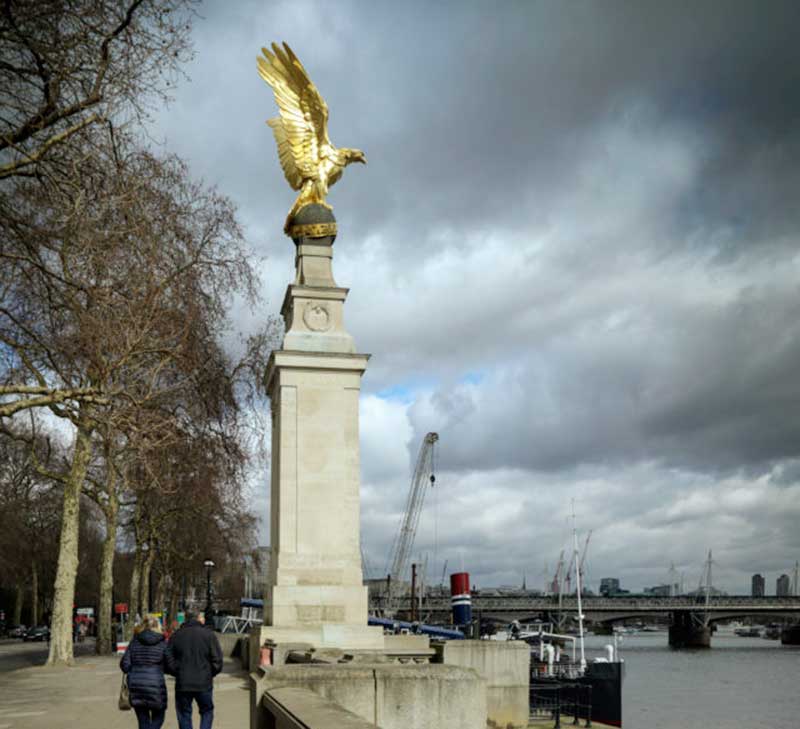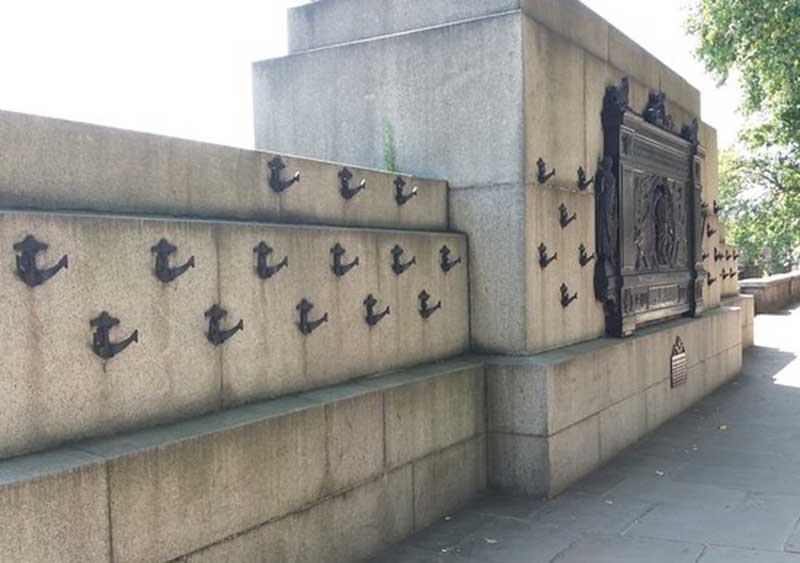London Neighbourhoods
Victoria Embankment
A popular spot in Central London, Victoria Embankment is part of the Thames Embankment, a road and river-walk along the north bank of the River Thames. Built in the 1860s, it runs from the Palace of Westminster to Blackfriars Bridge in the City of London, and acts as a major thoroughfare for road traffic between the City of Westminster and the City of London. It is noted for several memorials, such as the Battle of Britain Monument, permanently berthed retired vessels, such as HMS President, and public gardens, including Victoria Embankment Gardens.
The Victoria Embankment was one element of a three-part work, the other two parts being the Albert Embankment, from the Lambeth end of Westminster Bridge to Vauxhall; and the Chelsea Embankment, extending from Millbank to the Cadogan Pier at Chelsea, close by Battersea Bridge.
The project involved building out on to the foreshore of the River Thames, narrowing the river. The construction work required the purchase and demolition of much expensive riverside property. The cut-and-cover tunnel for the District Railway was built within the Embankment and roofed over to take the roadway.
he Victoria section was the most complex of the three sections. It was much larger, more complex and more significant to the metropolis than the other two and officially opened on 13 July 1870 by the Prince of Wales and Princess Louise. When people refer to "the Embankment" they are usually referring to that portion of it.
London Underground stations along Victoria Embankment are Embankment and Temple. London Buses route N550 is the only bus route along the Embankment, providing an overnight service when the tube is shut. Victoria Embankment was also the southern end of the Kingsway Tramway Subway.

Victoria Embarkment: See and Do
General Charles Gordon MemorialMajor-General Charles George Gordon CB (28 January 1833 – 26 January 1885), also known as Chinese Gordon, Gordon Pasha, and Gordon of Khartoum, was a British Army officer and administrator. He saw action in the Crimean War as an officer in the British Army. For his services in Crimea, he received the Crimean war medal and clasp. For the same services, he was appointed a Chevalier of the Legion of Honour by the Government of France on 16 July 1856.

Royal Air Force Memorial
The Royal Air Force Memorial is a military memorial on the Victoria Embankment in central London, dedicated to the memory of the casualties of the Royal Air Force in World War I (and, by extension, all subsequent conflicts). Unveiled in 1923, it is considered to be the official memorial of the RAF and related services.
It is sited at Whitehall Steps, near Cleopatra's Needle, between the north-bank ends of Charing Cross Bridge and Westminster Bridge, and directly to the east of the main Ministry of Defence building on Whitehall. The Fleet Air Arm Memorial and the Battle of Britain Monument are nearby.

National Submariners' War Memorial
The National Submariners' War Memorial is a war memorial on the Victoria Embankment,between Waterloo Bridge and Blackfriars Bridge. It commemorates the Royal Navy submariners who died in the First and Second World Wars. It is the focal point of a special memorial walk and laying of wreaths held each year by submariners on the Sunday preceding Remembrance Sunday.
The memorial stands on granite steps, supporting a large bronze bas relief within an architectural frame. The bas relief shows the interior of a submarine and another with nereids swimming on either side. To the right and left are allegorical figures representing Truth and Justice. On either side of the central bronze plaques are 40 bronze wreath hooks in the form of anchors.

Battle of Britain Monument
The Battle of Britain Monument in London is a sculpture on the Victoria Embankment, overlooking the River Thames, which commemorates the individuals who took part in the Battle of Britain during the Second World War. It was unveiled on 18 September 2005, the 65th anniversary of the Battle, by Prince Charles (now King Charles III) and Camilla, then Duchess of Cornwall, in the presence of many of the surviving airmen known collectively as "The Few", following the Royal Air Force Service of Thanksgiving and Rededication on Battle of Britain Sunday. This service is an annual event, the first of which took place in 1943 at St Paul's Cathedral and since has taken place in Westminster Abbey.
Cleopatra's Needle
Cleopatra's Needle is one of a pair of obelisks, together named Cleopatra's Needles, that were moved from the ruins of the Caesareum of Alexandria, in Egypt, in the 19th century. Inscribed by Thutmose III and later Ramesses II of the Egyptian New Kingdom, the obelisk was moved in 12 BC to Alexandria, where it remained for over 1,800 years. It was presented to the United Kingdom in 1819 by the ruler of Egypt and Sudan Muhammad Ali, in commemoration of the victories of Lord Nelson at the Battle of the Nile and Sir Ralph Abercromby at the Battle of Alexandria in 1801.
The obelisk was originally erected in the Egyptian city of Heliopolis on the orders of Thutmose III, around 1450 BC. It is of granite, brought from the quarries of Aswan, near the first cataract of the Nile. Thutmose III had a single column of text carved on each face, these were translated by E. A. Wallis Budge. Other inscriptions were added about 200 years later by Ramesses II to commemorate his military victories: these are in two columns on each face, flanking the original inscriptions. The obelisks were moved to Alexandria and set up in the Caesareum, a temple built by Cleopatra in honour of Mark Antony or Julius Caesar by the Romans in 12 BC, during the reign of Augustus, but were toppled some time later. This had the fortuitous effect of burying their faces and so preserving most of the hieroglyphs from the effects of weathering.
Cleopatra's Needle is flanked by two faux-Egyptian sphinxes, designed by the English architect George John Vulliamy. The sphinxes are cast in bronze and bear hieroglyphic inscriptions that say netjer nefer men-kheper-re di ankh, which translates as "the good god, Thuthmosis III given life". These sphinxes appear to be looking at the Needle rather than guarding it, due to the sphinxes' improper or backwards installation.
Embankment Station
Embankment Stationis served by the Circle, District, Northern and Bakerloo lines. On the Bakerloo line and the Charing Cross branch of the Northern line, the station is between Waterloo and Charing Cross stations; on the Circle and District lines, it is between Westminster and Temple and is in Travelcard Zone 1. The station has two entrances, one on Victoria Embankment and the other on Villiers Street. The station is adjacent to Victoria Embankment Gardens and is close to Charing Cross station, Embankment Pier, Hungerford Bridge, Cleopatra's Needle, the Royal Air Force Memorial, the Savoy Chapel and Savoy Hotel and the Playhouse and New Players Theatres.
The station was opened on 30 May 1870 by the DR (now the District line) when the railway extended its line from Westminster to Blackfriars. Due to its proximity to the South Eastern Railway's Charing Cross station, the station was originally called Charing Cross.
Temple Tube Station
Temple Underground station located at Victoria Embankment in the City of Westminster. It is on the Circle and District lines between Embankment and Blackfriars. The station was opened on 30 May 1870 with the name The Temple, from the Temple area in the vicinity of Temple Church, and from the Inner Temple and the Middle Temple, two of the four Inns of Court of London
.
Embankment Lion Heads
If you take a cruise or ferry ride on the Thames beside Victoria Embankment, you'll see a large number of bronze lion heads spaced out equidistantly and attached to the seawall. They were sculpted in 1868 by a Timothy Butler, who made them for the Sir Joseph Bazalgette, the made responsible for designing and installing London’s intricate sewage system between 1868-70, a system that is still operates today. A well known rhyme, often quoted by by guides abouard passing ferries, declares:
“When the Lions drink – London will sink.
When it’s up to their manes – we’ll go down the drains
When the water is sucked, we’re al ... in trouble”
The lions have mooring rings in their mouths, however there is no record of them ever having been put to this use, and the rings are too small to hold anything but very small vessels.
Ships permanently moored by Victoria Embankment include HMS President, HQS Wellington, and PS Tattershall Castle.
HMS President (1918)
HMS President (formerly HMS Saxifrage) is a retired Flower-class Q-ship that was launched in 1918. She was renamed HMS President in 1922 and moored permanently on the Thames as a Royal Navy Reserve drill ship. HMS Saxifrage escorted convoys in UK waters during 1918, and engaged nine U-boats, as recorded in her logbooks held in the National Archives at Kew. In 1922 she was permanently moored on the Thames, and renamed President. Other members of the class served as patrol vessels throughout the world during the peacetime years between the wars, but almost all were disposed of by the Second World War.

HQS Wellington
HMS Wellington (launched Devonport, 1934) is a Grimsby-class sloop, formerly of the Royal Navy. During the Second World War, she served as a convoy escort ship in the North Atlantic. She is now moored alongside the Victoria Embankment, at Temple Pier, on the River Thames in London, England. From 1948 to 2023 she was the headquarters ship of the Honourable Company of Master Mariners, known as HQS Wellington.
PS Tattershall Castle (1934)
PS Tattershall Castle is a floating pub and restaurant moored on the River Thames at Victoria Embankment. It was a passenger ferry across the Humber estuary from 1934 to 1973, before being towed to London in 1976. She plied the Humber Ferry route between Corporation Pier in Kingston upon Hull, Yorkshire, and New Holland Pier in New Holland, Lincolnshire.
In the Second World War she was a tether for barrage balloons and ferried troops and supplies along the Humber estuary. Due to the frequent heavy fogs on this river, she was fitted with radar, becoming one of the first civilian ships so equipped. After the war, with the nationalisation of the railways in 1948, she became part of British Rail's Sealink service. Tattershall Castle was first opened on the River Thames as a floating art gallery and then in 1982 as a restaurant.
Design by W3layouts

